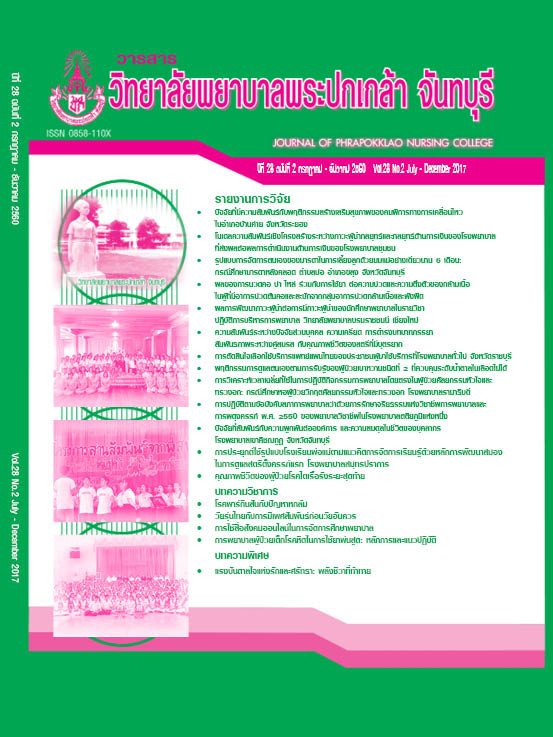Perceived Self-care Behaviors among Patients with Type 2 Diabetes Mellitus and Poor Glycemic Control
Keywords:
Perception, Self-care behavior, Type 2 diabetes mellitus, Poor glycemic controlAbstract
This qualitative research aimed to determine perceived self-care behaviors among patients with type 2 diabetes mellitus (T2DM) and poor glycemic control. The informants were 22 patients with T2DM and poor glycemic control receiving services at the extended out of patient department clinic, branch 1 of Phrae Hospital. The research instruments consisted of a questionnaire of personal characteristics and health informations, an semi-structured interview of self-care behaviors of patients with diabetes mellitus, and a tape recorder. Data were collected from May, 2014 to May, 2015 and were analyzed using frequency, percentage, mean, standard deviation, and content analysis.
The research results revealed that six main themes associated with uncontrolled blood glucose behaviors had emerged in the patients with T2DM as follows: 1) food consumption, especially having sticky rice, having salty, sweetie and spicy food; 2) alcohol drinking during traditional events, religious ceremony and social gatherings; 3) inadequate exercise because of tiredness after working and too short duration of exercise; 4) medication in-adherence, particularly forgetting taking medicine after dinner and using herbal medicine together with the treatment; 5) stress from their chronic illness and feeling fear of worst symptoms of their disease; and 6) loss of follow-up because of forgetting the follow-up date and do not want to visit the appointment.
This research suggested that nurses and healthcare providers should give health education to patients with diabetes mellitus under their social context and individual differences. This concludes the promotion of self-care awareness and blood sugar follow-up of patients with diabetes mellitus.
References
ขวัญหทัย ไตรพืช, พรทิพย์ มาลาธรรม, ขนิตฐา หาญประสิทธิ์คำ, และวิศาล คันธารัตนกุล. (2553). การสังเคราะห์งานวิจัยเกี่ยวกับการออกกำลังกายที่มีผลต่อการควบคุมระดับน้ำตาลในเลือดในผู้ป่วยเบาหวานชนิดที่ 2. รามาธิบดีพยาบาลสาร, 16(2), 259-278. สืบค้น วันที่ 17 มิถุนายน 2558, จาก https://www.tci-thaijo.org/index.php/RNJ/article/viewFile/8976/7634
คลินิกผู้ป่วยนอก สาขา 1 โรงพยาบาลแพร่. (2557). ข้อมูลผู้ป่วยเบาหวาน พ.ศ. 2555-2557. แพร่: ผู้แต่ง.
ฉัตรนภา หัตถโกศล. (2558). การเสพติดอาหาร. สืบค้น วันที่ 17 มิถุนายน 2558, จาก http://www.halalthailand.com/healthy/subindex.php?page=content&category=&subcatname=&subcat=&id=133.prd.go.th/ewt_dl_link.php?nid=111765&filename=happy8
ทรรศนีย์ สิริวัฒนพรกุล, นงนุช โอบะ, และสุชาดา อินทรกำแหง ณ ราชสีมา. (2550). ปัจจัยที่มีความสัมพันธ์กับระดับน้ำตาลในเลือดของผู้ป่วยเบาหวานชนิดที่ 2. วารสารพยาบาลศาสตร์ มหาวิทยาลัยนเรศวร, 1(2), 57-67.
เนติมา คูนีย์. (บ.ก.). (2555). แนวทางเวชปฏิบัติการออกกำลังกายในผู้ป่วยเบาหวานและความดันโลหิตสูง 2555. กรุงเทพฯ: สำนักงานกิจการโรงพิมพ์องค์การสงเคราะห์ทหารผ่านศึกในพระบรมราชูปถัมภ์. สืบค้น วันที่ 17 มิถุนายน 2558, จาก http://203.157.39.7/imrta/images/data/aw20130328.pdf
ปกาสิต โอวาทกานนท์. (2554). ผลการดูแลรักษาเบาหวานและปัจจัยที่มีความสัมพันธ์กับการไม่สามารถควบคุมระดับน้ำตาลในเลือดของผู้ป่วยเบาหวานชนิดที่ 2 ในโรงพยาบาลทรายมูล. ศรีนครินทร์เวชสาร, 26(4), 339-349. สืบค้น วันที่ 17 มิถุนายน 2558, จาก http://www.smj.ejnal.com/e-journal/showdetail/?show_preview=T&art_id=1685
พัชรินทร์ ชนะพาห์, และพิศมัย กิจเกื้อกูล. (2556). ความเครียดกับกลุ่มอาการทางเมตาบอลิก. สงขลานครินทร์เวชสาร, 31(5), 253-260. สืบค้น วันที่ 17 มิถุนายน 2558, จาก http://medinfo.psu.ac.th/smj2/31_5_2013/05_patcharin(56022).pdf
เพชร รอดอารีย์. (2550). ผลกระทบของโรคเบาหวานต่อสุขภาพและความเจ็บป่วย. ใน วรรณี นิธิยานันท์, สาธิต วรรณแสง, และชัยชาญ ดีโรจนวงศ์. (บ.ก.). สถานการณ์โรคเบาหวานในประเทศไทย. หน้า 20-27. กรุงเทพฯ: วิวัฒน์การพิมพ์.
เพรียวพันธุ์ อุสาย, นิรมล เมืองโสม, และประยูร โกวิทย์. (2555). ปัจจัยที่มีความสัมพันธ์กับการควบคุมระดับน้ำตาลในเลือดของผู้ป่วยเบาหวานชนิดที่ 2 ที่ขึ้นทะเบียนรักษาในโรงพยาบาลส่งเสริมสุขภาพตำบล เขตรับผิดชอบของโรงพยาบาลบ้านไผ่ จังหวัดขอนแก่น. วารสารสาธารณสุขศาสตร์ มหาวิทยาลัยขอนแก่น, 5(3), 11-20.
มยุรา อินทรบุตร, และเบญจา มุกตพันธุ์. (2550). การรับรู้และการปฏิบัติด้านการควบคุมอาหารของผู้ป่วยโรคเบาหวาน ประเภทที่ 2. สืบค้น วันที่ 18 ตุลาคม 2560, จาก http://www.smj.ejnal.com/e-journal/showdetail/?show_detail=T&art_id=1265
ฤทธิรงค์ บูรพันธ์, และนิรมล เมืองโสม. (2556). ปัจจัยที่มีผลต่อการควบคุมระดับน้ำตาลในเลือดไม่ได้ของผู้ป่วยเบาหวานชนิดที่ 2. วารสารวิจัยสาธารณสุข มหาวิทยาลัยขอนแก่น, 6(3), 102-109.
วรรณี นิธิยานันท์. (2559). คนไทยป่วยเบาหวาน พุ่งป่วยแล้ว 5 ล้าน ทำให้โรคแทรกซ้อนพบบ่อย ไตเรื้อรัง. สืบค้น วันที่ 3 กรกฎาคม 2560, จาก https://www.hfocus.org/content/2016/11/12992
วิชัย เอกพลากร, และคณะ. (2559). รายงานการสำรวจสุขภาพประชาชนไทยโดยการตรวจร่างกาย ครั้งที่ 5 พ.ศ. 2557. กรุงเทพฯ: อักษรกราฟฟิคแอนด์ดีไซน์. สืบค้น วันที่ 17 มิถุนายน 2558, จาก https://www.hsri.or.th/researcher/research/new-release/detail/7711
วิมลรัตน์ จงเจริญ, และคณะ. (2551). รูปแบบการส่งเสริมการดูแลตนเองเพื่อควบคุมระดับน้ำตาลในเลือดของผู้ป่วยเบาหวานชนิดที่ 2. สงขลานครินทร์เวชสาร, 26(1), 71-84. สืบค้น วันที่ 17 มิถุนายน 2558, จาก http://medinfo.psu.ac.th/smj2/26_1/pdf26_1/08.pdf
ศูนย์เทคโนโลยีสารสนเทศและการสื่อสาร สำนักงานประชาสัมพันธ์เขต 3 จังหวัดเชียงใหม่. (2557). สถานการณ์โรคเบาหวานและความดันโลหิตสูง จังหวัดแพร่. สืบค้น วันที่ 3 กรกฎาคม 2560, จาก http://phrae.prdnorth.in.th/ ct/news/viewnews.php?ID=140603133943
สำนักนโยบายและยุทธศาสตร์ กระทรวงสาธารณสุข. (2559). สถิติสาธารณสุข พ.ศ. 2558. สืบค้น วันที่ 3 กรกฎาคม 2560, จาก https://www.m- society.go.th/article_ attach/18527/20347.pdf
อนุสรณ์ ลังกาพินธ์. (2552). ผลกระทบของการเกิดอนุมูลอิสระจากโรคเบาหวานต่อการทำงานของไต. ลำปางเวชสาร, 30(2), 75-83. สืบค้น วันที่ 17 มิถุนายน 2558, จาก http://thailand.digitaljournals.org/index.php/LMJ/article/view/1343
Howard, A. A., Arnsten, J. H., & Gourevitch, M. N. (2004). Effect of alcohol consumption on diabetes mellitus: A systematic review. Annals of Internal Medicine, 140(3), 211-219. Retrieved July 3, 2017, from https://www.ncbi.nlm.nih.gov/pubmed/14757619
International Diabetes Federation. (2015). IDF diabetes atlas (7th ed.). Retrieved July 3, 2017, from https://www.idf.org/about-diabetes/what-is-diabetes.html
Miles, M. B., & Huberman, A. M. (1994). Qualitative data analysis: An expanded sourcebook (2nd ed.). London: SAGE Publications.
Rubin, R. R., & Peyrot, M. (2001). Psychological issues and treatments for people with diabetes. Journal of Clinical Psychology, 57(4), 457-478. Retrieved July 3, 2017, from https://www.ncbi.nlm.nih.gov/pubmed/11255202
van de Wiel, A. (2004). Diabetes mellitus and alcohol. Diabetes/Metabolism Research and Reviews, 20(4), 263-267. Retrieved July 3, 2017, from https://www.ncbi.nlm.nih.gov/pubmed/15250029
Downloads
Published
How to Cite
Issue
Section
License
Copyright (c) 2017 Journal of Phrapokklao Nursing College

This work is licensed under a Creative Commons Attribution-NonCommercial-NoDerivatives 4.0 International License.
เนื้อความ ข้อมูล และรายการอ้างอิงที่ผู้เขียนใช้ในการเขียนบทความเพื่อลงตีพิมพ์ในวารสารวิทยาลัยพยาบาลพระปกเกล้า จันทบุรี ถือเป็นความคิดเห็นและความรับผิดชอบของผู้เขียน คณะผู้จัดทำวารสารไม่จำเป็นต้องเห็นพ้องด้วยหรือร่วมรับผิดชอบ
บทความที่ได้รับการลงตีพิมพ์ในวารสารวิทยาลัยพยาบาลพระปกเกล้า จันทบุรี ถือเป็นลิขสิทธิ์ของวารสารวิทยาลัยพยาบาลพระปกเกล้า จันทบุรี หากหน่วยงานหรือบุคคลใดต้องการนำส่วนหนึ่งหรือทั้งหมดของบทความไปเผยแพร่ต่อเพื่อวัตถุประสงค์ใด ๆ จะต้องได้รับอนุญาตจากบรรณาธิการวารสารก่อน



